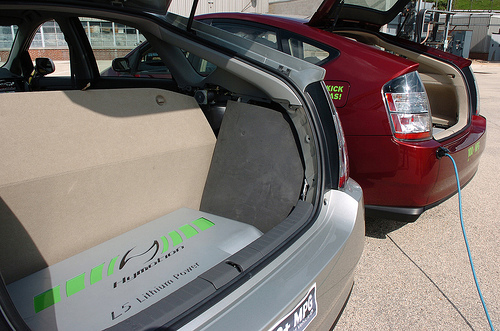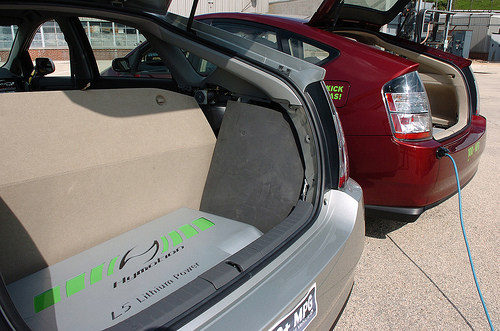 Is Congress moving us toward a fuel-efficient future? Plug-in hybrid electric cars could be the cars of tomorrow.Photo courtesy of Argonne National Laboratory
Is Congress moving us toward a fuel-efficient future? Plug-in hybrid electric cars could be the cars of tomorrow.Photo courtesy of Argonne National Laboratory
Oil, oil, everywhere, but not a drop for fuel. This is the stark view of Gulf Coast residents who see a 24,500 square mile oil slick menacing their shores. The devastating BP oil disaster has clearly increased the urgency to dramatically reduce America’s oil consumption; and cutting our consumption would save consumers money, reduce foreign oil imports, help our economy, increase national security, and reduce global warming pollution.
Senate Majority Leader Harry Reid (D-Nev.) has indicated that oil use reduction (or “oil savings”) provisions would be a central element of the clean energy legislation he plans to bring to the Senate floor in mid July. And a number of other senators have introduced legislation that would either reduce oil use from many sources or focus on a specific sector. By selecting the best provisions from each bill it’s possible to craft a program that would reduce oil use by one-third or more by 2030.
There are three primary ways to reduce oil use: make cars much more fuel efficient, launch cleaner alternative fuels such as electricity for cars and natural gas for trucks, and invest in public transportation. CAP evaluated the major oil savings proposals in senators’ bills that address all three of these needs and chose the provisions with the most oil savings in each category. These provisions could form the basis for an oil savings section of a comprehensive clean energy and global warming bill.
Proposed oil savings provisions that will make a difference:
Establish an oil savings goal: Sen. Jeff Merkley’s (D-Ore.) National Oil Independence Program is in discussion draft form. It would establish a goal of reducing oil use by eight million barrels-per-day in 2030, which equals current imports from every major nation except Canada.
Improve fuel economy for cars and light trucks: Sen. Merkley’s plan would increase fuel economy requirements by 6 percent annually from 2017 to 2030. This would increase fuel economy standards to 44.8 miles per gallon for model year 2020, and to 60 MPG for model year 2025. These fuel economy standards are realistic. Sen. Merkley noted that “China will be requiring its vehicles to achieve 42.2 MPG by 2015.”
President Barack Obama also ordered the Environmental Protection Agency and the Department of Transportation to develop new fuel economy and greenhouse pollution standards for model years 2017 to 2021.
Begin fuel economy standards for medium and heavy-duty trucks: Fuel economy standards have never existed for these size trucks even though they’re gas guzzlers. Medium trucks get an average of 9.7 miles per gallon, while heavy trucks get 6.5 miles per gallon. Sen. Merkley’s plan would set the first standard for these vehicles of 15.8 MPG and 10.4 MPG, respectively, by 2030. This would save an estimated 400,000 barrels of oil per day. The Obama administration is also developing the first-ever fuel economy standards for these vehicles.
Establish a “fee bate” program to encourage the purchase of fuel-efficient cars: A “fee bate” program encourages drivers to buy more efficient vehicles by providing cash back for buying cars that are more fuel efficient than the average vehicle in that class. This program is paid for by levying a surcharge on vehicles that are below average in fuel economy in a particular class.
Two bills would establish a fee bate system to boost the purchase of high-efficiency cars. The Efficient Vehicle Leadership Act, S. 1620, sponsored by Sen. Jeff Bingaman (D-N.M.), and the Practical Energy and Climate Plan, S. 3464, sponsored by Sen. Richard Lugar (R-Ind.), both have fee bate programs. Bingaman’s bill would provide $2,500 and $3,500 rebates for cars that are 50 percent and 75 percent more fuel efficient than the average car in their class. Sen. Lugar’s provision is very similar to S. 1620, which he has cosponsored.
Charge up the electric car industry: One way to dramatically reduce oil use is by developing, producing, and using cars completely or primarily powered by electric batteries rather than gasoline. These cars also produce less global warming and other pollution compared to conventional gasoline vehicles, and are cheaper to operate too. The Chevrolet Volt, which is the first plug-in hybrid electric vehicle, or PHEV, should be available later this year, and it could get 230 MPG.
President Obama set a goal of 1 million PHEVs by 2015. Incentives for purchasing electric vehicles and creation of the infrastructure to recharge them are essential to meeting this goal. The Electric Vehicle Deployment Act, S. 3442, sponsored by Sens. Byron Dorgan (D-N.D.), Lamar Alexander (R-Tenn.), and Merkley, would establish a comprehensive program to boost electric vehicle use. In addition to providing incentives for the purchase of electric vehicles, it would also provide $800 million to five as yet unselected communities to deploy 700,000 electric vehicles by 2016.
Fill up more trucks and buses with natural gas: Electricity is an excellent alternative fuel for passenger vehicles, but unfortunately it won’t work for heavier trucks and buses. The large amounts of energy needed to power these weightier vehicles would require too many batteries that would add too much weight and take up too much space. Instead, natural gas — in the form of liquefied natural gas, or LNG, or compressed natural gas, or CNG — is an ideal alternative fuel for these vehicles. Because many of these vehicles are short haul, centrally fueled vehicles, only a limited number of natural gas refueling stations are necessary.
LNG or CNG produces one-quarter of the global warming pollution compared to oil-based fuels. And CAP analysis shows that by 2035 natural gas heavy trucks could reduce oil use by 1.2 million barrels per day, or 45 percent of the projected oil consumption of heavy trucks by 2035. These fuels are cheaper per mile compared to diesel fuel as well (if oil is more than $31 per barrel).
The NAT GAS Act, S. 1408, sponsored by Sens. Robert Menendez (D-N.J.), Harry Reid (D-Nev.), and Orrin Hatch (R-Utah), would create incentives for trucking companies and bus fleets to purchase trucks and buses powered by natural gas. It would also provide incentives for investments in natural gas fueling infrastructure. Versions of this proposal are also included in the American Power Act discussion draft sponsored by Sens. John Kerry (D-Mass.) and Joe Lieberman (I-Conn.), as well as in the Merkley proposal.
Implement fuel-efficiency measures for off-road vehicles and other transportation: Off-road and construction vehicles, planes, trains, and boats all use oil-based fuels. Airplanes, for instance, consume about 15 percent of all finished petroleum products. The American Power Act and American Clean Energy and Security Act, H.R. 2454, include very similar provisions to identify nonroad vehicles and engines that contribute to global warming pollution and provide cost effective solutions. Sen. Merkley’s plan, however, seems to have the most specific requirements.
Invest in more efficient transportation infrastructure: Investments in public transit, high-speed rail, and other low-oil infrastructure are essential to reducing oil use after tackling vehicles and fuels. Transportation for America estimates that the efficiency measures in its “‘Route to Reform’ could reduce oil consumption by more than a million barrels a day by 2030.”
The American Power Act, or APA, would invest $6 billion annually in “transportation infrastructure to increase efficiency and decrease oil consumption … [including] almost $2 billion for state and local projects that reduce oil consumption and greenhouse gases.” APA would fund other transit projects too, and it would pay for these investments with revenue from the auction or sale of greenhouse gas pollution allowances.
Boost renewable fuel use: The Energy Independence and Security Act of 2007 includes a renewable fuel standard that requires the production of 22 billion gallons of advanced biofuels by 2022, which would save over half a million barrels of oil daily. Nonetheless, the production of these cleaner fuels could easily fall short of this requirement. The Practical Energy and Climate bill would include advanced biofuels as part of a reverse auction established by the Energy Policy Act of 2005 that will create significant incentives to encourage low-cost innovation and commercial scale deployment of advanced biofuels to push these U.S.-based fuels from the laboratory to the road.
Paying for reduction programs:
Admittedly, funding for these and other programs may be difficult to come by during this era of trillion-dollar deficits. Only the American Power Act’s provisions come with their own revenue-generating mechanism: the funds from auctioning pollution allowances to the largest carbon emitters under a carbon limitation program. CAP estimates that the funds from APA’s limit on carbon pollution from coal-fired power plants alone could generate $80 billion annually for investment in these and other clean energy technologies. Eliminating $45 billion worth of tax loopholes for big oil companies could also provide revenue to fund oil savings programs. These taxpayer handouts are unnecessary in an industry where the five largest companies made nearly a trillion dollars in profits in the past decade.
Sen. Mary Landrieu (D-La.) noted that, “In all of the climate bills, there are significant revenues generated, so that is a possibility. But if we did an energy-only bill, we’re going to be struggling about how to provide revenues.” This means that setting a shrinking limit on global warming pollution, closing tax loopholes, or creating some other reliable revenue stream is essential for funding the programs to significantly reduce our oil use.
There’s a bipartisan theme to the oil savings measures listed here — the six different bills are sponsored by progressive and moderate Democrats and conservative Republicans. Taken together, they would jumpstart our nation’s effort to reduce our oil use while creating jobs and enhancing our national security. And the less oil we need, the less likely we are to search for it a mile deep below the surface where a BP-type blowout could devastate our health, economy, and environment.
The American people overwhelmingly support efforts to cut our oil addiction and slash global warming pollution. Now they’re looking to the Senate for action this summer as part of comprehensive clean energy and global warming pollution reduction legislation.




